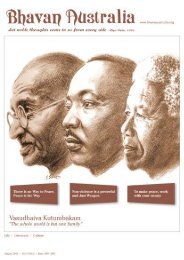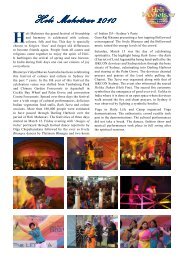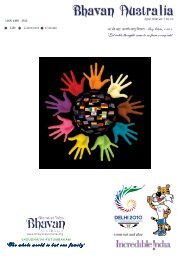Programme Brochure - Bharatiya Vidya Bhavan Australia
Programme Brochure - Bharatiya Vidya Bhavan Australia
Programme Brochure - Bharatiya Vidya Bhavan Australia
You also want an ePaper? Increase the reach of your titles
YUMPU automatically turns print PDFs into web optimized ePapers that Google loves.
The colourful festival of Holi is celebrated on<br />
Phalgun Purnima which comes in February end<br />
or early March. Holi festival has an ancient<br />
origin and celebrates the triumph of ‘good’ over ‘bad’.<br />
The colourful festival bridges the social gap and renews<br />
sweet relationships. On this day, people hug and wish<br />
each other ‘Happy Holi’.<br />
Holi celebration begins with lighting up of bonfire on<br />
the Holi eve. Numerous legends and stories associated<br />
with Holi celebration make the festival more exuberant<br />
and vivid. People rub ‘gulal’ and ‘abeer’ on each others’<br />
faces and cheer up saying, “bura na maano Holi hai”.<br />
Holi also gives a wonderful chance to send blessings<br />
and love to dear ones wrapped in a special Holi gift.<br />
History of Holi<br />
Holi is an ancient festival of India and was originally<br />
known as ‘Holika’. Historians also believe that Holi was<br />
celebrated by all Aryans but more so in the Eastern part<br />
of India. It is said that Holi existed several centuries<br />
before Christ. The festival used to be a special rite<br />
performed by married women for the happiness and<br />
well-being of their families and the full moon (Raka) was<br />
worshiped. The full moon festival of Holika gradually<br />
became a festival of merrymaking, announcing the<br />
commencement of the spring season.<br />
Reference in Ancient Texts and<br />
Inscriptions<br />
Holi Mahotsav<br />
Besides having a detailed description in the Vedas and<br />
Puranas such as Narad Purana and Bhavishya Purana,<br />
the festival of Holi finds a mention in Jaimini Mimansa.<br />
A stone inscription belonging to 300 BC found at<br />
Ramgarh in the province of Vindhya has mention<br />
of Holikotsav on it. King Harsha, too has mentioned<br />
about Holikotsav in his work Ratnavali that was written<br />
during the 7th century.<br />
The famous Muslim tourist, Ulbaruni too has mentioned<br />
about Holikotsav in his historical memories. Other<br />
Muslim writers of that period have mentioned, that<br />
Holikotsav was not only celebrated by the Hindus but<br />
also by the Muslims.<br />
Reference in Ancient Paintings and<br />
Murals<br />
-Parveen<br />
The festival of Holi also finds a reference in the<br />
sculptures on walls of old temples. A 16th century panel<br />
sculpted in a temple at Hampi, capital of Vijayanagar,<br />
shows a joyous scene of Holi. The painting depicts a<br />
Prince and his Princess standing amidst maids waiting<br />
with syringes or pichkaris to drench the Royal couple in<br />
coloured water.<br />
A 16th century Ahmednagar painting is on the theme<br />
of Vasanta Ragini—spring song or music. It shows a<br />
royal couple sitting on a grand swing, while maidens<br />
are playing music and spraying colours with pichkaris.<br />
There are a lot of other paintings and murals in the temples<br />
of medieval India which provide a pictorial description<br />
of Holi. For instance, a Mewar painting (circa 1755)<br />
shows the Maharana with his courtiers. While the ruler<br />
is bestowing gifts on some people, a merry dance is on,<br />
and in the center is a tank filled with coloured water.<br />
Also, a Bundi miniature shows a king seated on a tusker<br />
and from a balcony above some damsels are showering<br />
gulal (coloured powders) on him.<br />
Legends and Mythology<br />
In some parts of India, specially in Bengal and Orissa,<br />
Holi Purnima is also celebrated as the birthday of Shri<br />
Chaitanya Mahaprabhu (A.D. 1486–1533). However,<br />
the literal meaning of the word ‘Holi’ is ‘burning’.<br />
There are various legends to explain the meaning of this<br />
word, most prominent of all is the legend associated<br />
with demon king Hiranyakashyap.<br />
Hiranyakashyap wanted everybody in his kingdom to<br />
worship only him but to his great disappointment, his









